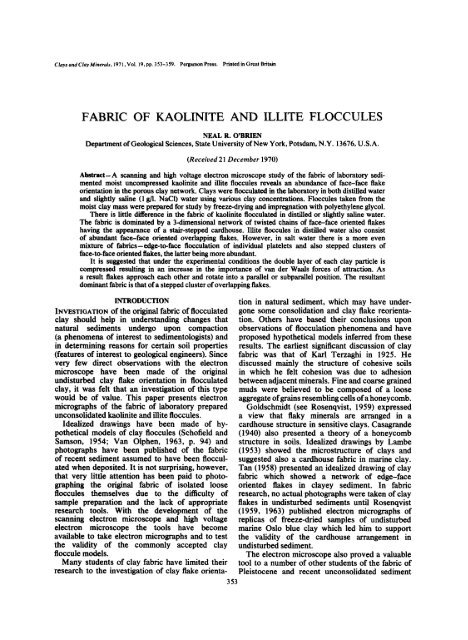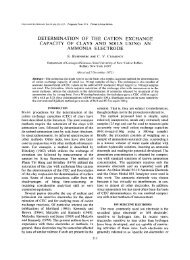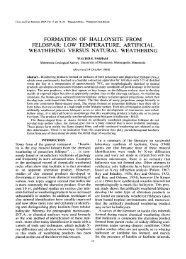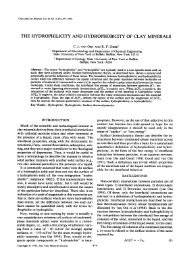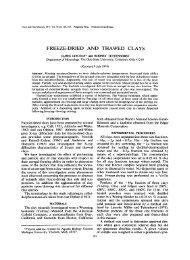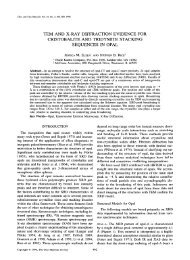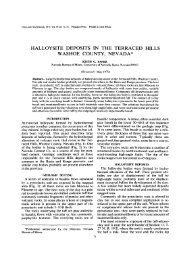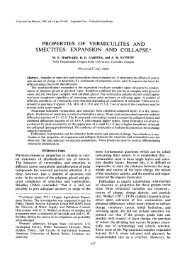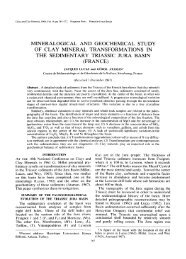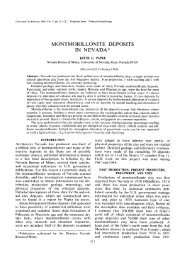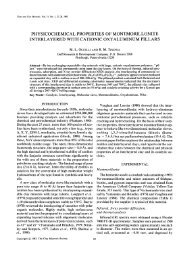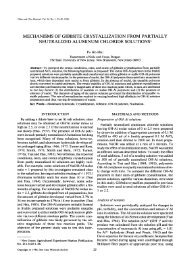fabric of kaolinite and illite floccules - Clay Minerals Society
fabric of kaolinite and illite floccules - Clay Minerals Society
fabric of kaolinite and illite floccules - Clay Minerals Society
You also want an ePaper? Increase the reach of your titles
YUMPU automatically turns print PDFs into web optimized ePapers that Google loves.
<strong>Clay</strong>s <strong>and</strong> <strong>Clay</strong> <strong>Minerals</strong>, 1971, Vol. 19, pp. 353-359. Pergamon Press. Printed in Great Britain<br />
FABRIC OF KAOLINITE AND ILLITE FLOCCULES<br />
NEAL R. O'BRIEN<br />
Department <strong>of</strong> Geological Sciences, State University <strong>of</strong> New York, Potsdam, N.Y. 13676, U.S.A.<br />
(Received 21 December 1970)<br />
Abstraet-A scanning <strong>and</strong> high voltage electron microscope study <strong>of</strong> the <strong>fabric</strong> <strong>of</strong> laboratory sedi-<br />
mented moist uncompressed <strong>kaolinite</strong> <strong>and</strong> <strong>illite</strong> <strong>floccules</strong> reveals an abundance <strong>of</strong> face-face flake<br />
orientation in the porous clay network. <strong>Clay</strong>s were flocculated in the laboratory in both distilled water<br />
<strong>and</strong> slightly saline (1 g/l. NaCI) water using various clay concentrations. Floccules taken from the<br />
moist clay mass were prepared for study by freeze-drying <strong>and</strong> impregnation with polyethylene glycol.<br />
There is little difference in the <strong>fabric</strong> <strong>of</strong> <strong>kaolinite</strong> flocculated in distilled or slightly saline water.<br />
The <strong>fabric</strong> is dominated by a 3-dimensional network <strong>of</strong> twisted chains <strong>of</strong> face-face oriented flakes<br />
having the appearance <strong>of</strong> a stair-stepped cardhouse. Illite <strong>floccules</strong> in distilled water also consist<br />
<strong>of</strong> abundant face-face oriented overlapping flakes. However, in salt water there is a more even<br />
mixture <strong>of</strong> <strong>fabric</strong>s-edge-to-face flooculation <strong>of</strong> individual platelets <strong>and</strong> also stepped clusters <strong>of</strong><br />
face-to-face oriented flakes, the latter being more abundant.<br />
It is suggested that under the experimental conditions the double layer <strong>of</strong> each clay panicle is<br />
compressed resulting in an increase in the importance <strong>of</strong> van der Waals forces <strong>of</strong> attraction. As<br />
a result flakes approach each other <strong>and</strong> rotate into a parallel or subparallel position. The resultant<br />
dominant <strong>fabric</strong> is that <strong>of</strong> a stepped cluster <strong>of</strong> overlapping flakes.<br />
INTRODUCTION<br />
tion in natural sediment, which may have under-<br />
INVESTIGATION <strong>of</strong> the original <strong>fabric</strong> <strong>of</strong> flocculated gone some consolidation <strong>and</strong> clay flake reorientaclay<br />
should help in underst<strong>and</strong>ing changes that tion. Others have based their conclusions upon<br />
natural sediments undergo upon compaction observations <strong>of</strong> flocculation phenomena <strong>and</strong> have<br />
(a phenomena <strong>of</strong> interest to sedimentologists) <strong>and</strong> proposed hypothetical models inferred from these<br />
in determining reasons for certain soil properties results. The earliest significant discussion <strong>of</strong> clay<br />
(features <strong>of</strong> interest to geological engineers). Since <strong>fabric</strong> was that <strong>of</strong> Karl Terzaghi in 1925. He<br />
very few direct observations with the electron discussed mainly the structure <strong>of</strong> cohesive soils<br />
microscope have been made <strong>of</strong> the original in which he felt cohesion was due to adhesion<br />
undisturbed clay flake orientation in flocculated between adjacent minerals. Fine <strong>and</strong> coarse grained<br />
clay, it was felt that an investigation <strong>of</strong> this type muds were believed to be composed <strong>of</strong> a loose<br />
would be <strong>of</strong> value. This paper presents electron aggregate <strong>of</strong> grains resembling cells <strong>of</strong> a honeycomb.<br />
micrographs <strong>of</strong> the <strong>fabric</strong> <strong>of</strong> laboratory prepared Goldschmidt (see Rosenqvist, 1959) expressed<br />
unconsolidated <strong>kaolinite</strong> <strong>and</strong> <strong>illite</strong> <strong>floccules</strong>.<br />
a view that flaky minerals are arranged in a<br />
Idealized drawings have been made <strong>of</strong> hy- cardhouse structure in sensitive clays. Casagr<strong>and</strong>e<br />
pothetical models <strong>of</strong> clay <strong>floccules</strong> (Sch<strong>of</strong>ield <strong>and</strong> (1940) also presented a theory <strong>of</strong> a honeycomb<br />
Samson, 1954; Van Olphen, 1963, p. 94) <strong>and</strong> structure in soils. Idealized drawings by Lambe<br />
photographs have been published <strong>of</strong> the <strong>fabric</strong> (1953) showed the microstructure <strong>of</strong> clays <strong>and</strong><br />
<strong>of</strong> recent sediment assumed to have been floccul- suggested also a cardhouse <strong>fabric</strong> in marine clay.<br />
ated when deposited. It is not surprising, however, Tan (1958) presented an idealized drawing <strong>of</strong> clay<br />
that very little attention has been paid to photo- <strong>fabric</strong> which showed a network <strong>of</strong> edge-face<br />
graphing the original <strong>fabric</strong> <strong>of</strong> isolated loose oriented flakes in clayey sediment. In <strong>fabric</strong><br />
<strong>floccules</strong> themselves due to the difficulty <strong>of</strong> research, no actual photographs were taken <strong>of</strong> clay<br />
sample preparation <strong>and</strong> the lack <strong>of</strong> appropriate flakes in undisturbed sediments until Rosenqvist<br />
research tools. With the development <strong>of</strong> the<br />
scanning electron microscope <strong>and</strong> high voltage<br />
(1959, 1963) published electron micrographs <strong>of</strong><br />
replicas <strong>of</strong> freeze-dried samples <strong>of</strong> undisturbed<br />
electron microscope the tools have become<br />
available to take electron micrograplis <strong>and</strong> to test<br />
marine Oslo blue clay which led him to support<br />
the validity <strong>of</strong> the cardhouse arrangement in<br />
the validity <strong>of</strong> the commonly accepted clay<br />
floccule models.<br />
Many students <strong>of</strong> clay <strong>fabric</strong> have limited their<br />
research to the investigation <strong>of</strong> clay flake orientaundisturbed<br />
sediment.<br />
The electron microscope also proved a valuable<br />
tool to a number <strong>of</strong> other students <strong>of</strong> the <strong>fabric</strong> <strong>of</strong><br />
Pleistocene <strong>and</strong> recent unconsolidated sediment<br />
353
354 NEAL R. O'BRIEN<br />
(O'Brien <strong>and</strong> Harrison, 1967; Gillott, 1969). Pusch<br />
(1962, 1966, 1968) studied in the electron micro-<br />
scope ultra-thin sections <strong>of</strong> methacrylate <strong>and</strong><br />
carbowax impregnated s<strong>of</strong>t natural clays. He<br />
concluded that the structure <strong>of</strong> flocculated sediment<br />
is characterized by a network <strong>of</strong> large particles<br />
tied together by small particles arranged in groups<br />
or chains. His hypothetical floccule (Pusch, 1962,<br />
p. 53) showed individual flakes oriented in both<br />
a edge-face <strong>and</strong> edge-edge manner. Bowles<br />
(1968) studied marine sediment from the Gulf <strong>of</strong><br />
Mexico using techniques similar to Pusch's.<br />
He stated that it is unreasonable to conclude that<br />
the microstructure <strong>of</strong> undisturbed marine sediment<br />
resembles only a cardhouse or a honeycomb<br />
although it does appear to resemble more closely<br />
Terzaghi's honeycomb idealization. Later work by<br />
Bowles, Bryant <strong>and</strong> Wallin (1969) suggested that<br />
unconsolidated sediment may also be composed<br />
<strong>of</strong> packets <strong>of</strong> parallel oriented particles, although<br />
their results were inconclusive.<br />
Van Olphen (1963, pp. 94-95) summarized<br />
modes <strong>of</strong> particle association in flocculated clay<br />
suspensions <strong>and</strong> appropriate terminology which<br />
is a useful frame <strong>of</strong> reference in this discussion.<br />
The phenomenon <strong>of</strong> flocculation is observed when<br />
particles in suspension begin to stick together<br />
upon collision, <strong>and</strong> the agglomerates grow in size<br />
<strong>and</strong> settle rather quickly. Three different modes<br />
<strong>of</strong> particle association may occur: face-face,<br />
edge-face, <strong>and</strong> edge-edge. The term "aggregated"<br />
is suggested for the face to face association <strong>of</strong><br />
several flakes. Thus individual flakes may be<br />
flocculated in an edge-edge <strong>and</strong> edge-face associa-<br />
tion, while aggregates (each composed <strong>of</strong> face-face<br />
associated flakes) may also be edge-edge or edge-<br />
face flocculated. These models resemble the<br />
typical clay cardhouse. Later the author will<br />
elaborate upon the validity <strong>of</strong> these models as<br />
a result <strong>of</strong> his study.<br />
PROCEDURE<br />
Two different sample preparation techniques<br />
were used to study floccule <strong>fabric</strong>:freeze-drying<br />
<strong>and</strong> polyethylene glycol No. 6000 impregnation.<br />
The freeze-dried samples were observed directly<br />
in the scanning electron microscope <strong>and</strong> ultrathin<br />
sections <strong>of</strong> the impregnated samples studied with<br />
the high voltage electron microscope. A freeze-<br />
drying technique has also been used to study<br />
the <strong>fabric</strong> <strong>of</strong> bentonite muds by Borst <strong>and</strong> Shell<br />
(1970). Moist samples were frozen on aluminum<br />
specimen stubs cooled with liquid nitrogen <strong>and</strong><br />
then observed with the SEM. X-ray analysis<br />
revealed r<strong>and</strong>om orientation present in the freeze-<br />
dried clay, therefore, they concluded, that in quick<br />
freezing ice formed in the vitreous state rather<br />
than as crystals, thereby preventing change in<br />
the <strong>fabric</strong>. Halberstadt et al. (1969) studied samples<br />
<strong>of</strong> silica <strong>and</strong> gelatin gels prepared by a liquid<br />
nitrogen freeze-dried technique <strong>and</strong> concluded<br />
"the gels were not damaged by this procedure <strong>and</strong><br />
the silica structure remained essentially intact".<br />
GiUott (1969) has suggested, however, ice crystals<br />
have more chance to form if moist samples are<br />
immersed directly in liquid nitrogen. To minimize<br />
the formation <strong>of</strong> ice crystals, he proposed freezing<br />
samples by immersion in a vessel containing<br />
isopentane surrounded by liquid nitrogen in an<br />
outer container, resulting in rapid freezing at<br />
a temperature below -130~ Gillott mentioned<br />
that since sublimation is normally carded out<br />
at higher temperatures, it is hoped that the <strong>fabric</strong><br />
<strong>of</strong> the clay prepared in this manner impedes<br />
recrystallization sufficiently to prevent serious<br />
damage from the growth <strong>of</strong> ice crystals.<br />
The material used for impregnation was similar<br />
to that used <strong>and</strong> described by Mitchell (1956)<br />
as Carbowax. He studied the <strong>fabric</strong> <strong>of</strong> impregnated<br />
wet clays as observed in thin sections <strong>and</strong> con-<br />
eluded that the technique gave thin sections that<br />
contained particles in the same position as in<br />
the original wet clay. Thus this author concluded<br />
that this technique would be a useful method to<br />
check the validity <strong>of</strong> clay <strong>fabric</strong> studied by the<br />
freeze drying technique.<br />
The clay <strong>fabric</strong> was observed to be very similar<br />
in clay prepared by these two different techniques,<br />
suggesting (1) that if any changes are produced they<br />
are identical for both alternative preparation<br />
procedures; or (2) neither preparation technique<br />
significantly altered the original floccule structure.<br />
The latter is assumed to be the case based primarily<br />
upon <strong>fabric</strong> similarities <strong>of</strong> the same clays prepared<br />
by the widely different techniques. Interpretations<br />
are based upon the validity <strong>of</strong> this assumption.<br />
Freeze-drying technique<br />
Samples <strong>of</strong> Georgia <strong>kaolinite</strong> (Hydrite PX) <strong>and</strong><br />
Grundite <strong>illite</strong> were flocculated in distilled <strong>and</strong><br />
slightly saline water. 50 g <strong>of</strong> <strong>kaolinite</strong> <strong>and</strong> <strong>illite</strong><br />
each were stirred into separate beakers each con-<br />
taining a liter <strong>of</strong> distilled water <strong>and</strong> then mixed in<br />
a blender for 5 min. Observation <strong>of</strong> the clay sus-<br />
pension under a binocular microscope indicated<br />
complete disaggregation; however, upon st<strong>and</strong>ing<br />
large <strong>floccules</strong> formed. 100 g <strong>of</strong> <strong>kaolinite</strong> <strong>and</strong> <strong>illite</strong><br />
were each stirred into separate jars containing<br />
distilled water <strong>and</strong> shaken by h<strong>and</strong> for I0 min.<br />
10 g <strong>of</strong> <strong>kaolinite</strong> <strong>and</strong> 5 g <strong>of</strong><strong>illite</strong> also were dispersed<br />
in 500 ml <strong>of</strong> distilled water (containing 20 ml dil.<br />
NH4OH) <strong>and</strong> mixed for 5 rain in a blender. The<br />
latter suspensions stood for one day in the
Fig. I. Stereo-pair electron micrograph <strong>of</strong> freeze-dried flocculated Georgia <strong>kaolinite</strong> (50 g[l. clay concentration<br />
in distilled water). Stepped face-face <strong>and</strong> edge-face flocculation is present. Scale 8000<br />
Fig. 2. Scanning electron micrograph <strong>of</strong> freeze-dried flocculated Georgia <strong>kaolinite</strong> (100 g/l. clay concentration<br />
in distilled water). Note long twisted chains <strong>of</strong> face-face flocculated flakes. Scale 6000<br />
Fig. 3. Scanning electron micrograph <strong>of</strong> freeze-dried flocculated Georgia <strong>kaolinite</strong> (100 g/l. clay concentra-<br />
tion in distilled water). Points x <strong>and</strong> y show face-face oriented flakes: Point z shows an area <strong>of</strong> edge-face<br />
flocculation. Scale 15,000 x.<br />
[Facing page 354]
Fig. 4. High voltage r micrograph <strong>of</strong> polyethylene glycol impregnated flocculated Georgia <strong>kaolinite</strong><br />
(50 g/l. clay concentration in distilled water). Notice porous <strong>fabric</strong> <strong>of</strong> the flocculated clay. Scale 33,000 x.<br />
Fig. 5. Stereo-pair scanning electron micrograph <strong>of</strong> freeze-dried flocculated Georgia <strong>kaolinite</strong> (10 g/l. clay<br />
concentration in salt water, 1 g/1. NaCI). Note stepped clusters <strong>of</strong> face-face oriented flakes in the center<br />
<strong>of</strong> photograph. Scale 8000 x.<br />
Fig. 6. Scanning electron micrograph <strong>of</strong> freeze-dried flocculated Georgia <strong>kaolinite</strong> (10 g/l. clay concentration<br />
in salt water, 1 g/1. NaC1). Notice long chains composing the floccule sides. Scale 6000 x.<br />
Fig. 7. High voltage electron micrograph <strong>of</strong> polyethylene glycol impregnated flocculated Georgia <strong>kaolinite</strong><br />
(10 g/l. clay concentration in salt water, 1 g/l. NaCI). Scale 45000
Fig. 9. Stereo-pair scanning electron micrograph <strong>of</strong> flocculated grundite <strong>illite</strong> (50 g/l. clay concentration in<br />
distilled water). Scale 6000<br />
Fig. 10. Scanning electron micrograph <strong>of</strong> freeze-dried flocculated grundite <strong>illite</strong> (100 g/1. clay concentration<br />
in distilled water). Scale 8000<br />
Fig. 12. Scanning electron micrograph <strong>of</strong> freeze-dried flocculated grundite <strong>illite</strong> (100 g/l. clay concentration<br />
in distilled water). Scale 10,000 x.
Fig. 13. Stereo-pair scanning electron micrographs <strong>of</strong> freeze-dried flocculated grundite <strong>illite</strong> (5 g/l. clay<br />
concentration in salt water, 1 g/1. NaC1). Scale 8000 x.<br />
Fig. 14. High voltage electron micrograph <strong>of</strong> polyethylene glycol impregnated flocculated grundite <strong>illite</strong><br />
(5 g/l. clay concentration in salt water, 1 g/l. NaCI). Scale 12,800<br />
Fig. 15. High voltage electron micrograph <strong>of</strong> polyethylene glycol impregnated flocculated grundite iUite<br />
(5 g/l. clay concentration in salt water, 1 g/l, NaCl). Scale 12,800
Table 1. <strong>Clay</strong> <strong>and</strong> NaCI concentrations used in <strong>fabric</strong><br />
study<br />
<strong>Clay</strong> concentration (g/l.) NaCI concentration (g[l.) pH<br />
Georgia <strong>kaolinite</strong> 50 0 (distilled water) 5.0<br />
100 0 (distilled water) 7.8<br />
l0 1 8-4<br />
Grundite <strong>illite</strong> 50 0 (distilled water) 7.1<br />
I00 0 (distilled water) 4.5<br />
5 1 10"2<br />
laboratory <strong>and</strong> were observed to be well dispersed.<br />
Then each clay suspension was mixed with an<br />
equal amount <strong>of</strong> NaCI solution so that the final<br />
concentration equaled 1 g NaCI per liter <strong>of</strong> distilled<br />
water. Table 1 summarizes final clay <strong>and</strong> salt<br />
concentrations plus pH values <strong>of</strong> the final sus-<br />
pensions used in the experiments.<br />
A drop <strong>of</strong> each flocculated clay suspension was<br />
then deposited on a small 7 mm dia. aluminum<br />
disc producing a sphere. Each sample was frozen<br />
quickly by being submerged slowly into a container<br />
<strong>of</strong> liquid isopentane (temperature -140~ sur-<br />
rounded by liquid nitrogen in an outer container.<br />
Then frozen samples were put into a cold vacuum<br />
chamber <strong>and</strong> the ice removed by sublimation under<br />
a vacuum <strong>of</strong> approximately 7 x i0 -amm Hg for<br />
4 hr. During this time the chamber was kept at<br />
-15 ~ to -20~ in a salt-ice mixture. The dried<br />
powdery samples were removed <strong>and</strong> gold shadowed<br />
(200-300 A thick) to prepare them for scanning<br />
electron microscope study. A JEOL, JSM-2<br />
microscope was used in this study.<br />
Polyethylene glycol technique<br />
The same flocculated clay suspensions described<br />
in the previous section (Table t) were also used in<br />
preparing the clay for the high voltage electron<br />
microscope investigation. Others (Martin, 1966;<br />
Quigley <strong>and</strong> Thompson, 1966), have used poly-<br />
ethylene glycol No. 6000 for X-ray diffraction<br />
analysis <strong>of</strong> moist clay <strong>fabric</strong>. The flocculated clay<br />
masses were poured into small beakers <strong>and</strong> allowed<br />
to settle for I hr. Most <strong>of</strong> the clear overlying water<br />
was siphoned <strong>of</strong>f, leaving only a few millimeters<br />
<strong>of</strong> clear water at the sediment-water interface.<br />
Then warm liquid polyethylene glycol No. 6000<br />
(melting point 55~176 at 70~ was carefully<br />
poured down the side <strong>of</strong> each beaker so as not to<br />
stir up the clay. Beakers were put into an oven,<br />
loosely covered with aluminum foil lids <strong>and</strong> kept.<br />
at 70~ for over 2 weeks, during which time the:<br />
moist clay became entirely impregnated with the:<br />
wax. Then the beakers were removed <strong>and</strong> the wax:<br />
impregnated samples were allowed to harden at:<br />
room temperature. Thin sections (1/z thick) were~<br />
KAOLINITE AND ILL1TE 355<br />
prepared by using a microtome, <strong>and</strong> mounted on<br />
200 mesh copper screens for viewing.<br />
Because <strong>of</strong> the thickness <strong>of</strong> the sections, it was<br />
necessary to use for viewing a 500 kV high voltage<br />
electron microscope developed by the Shimadzu<br />
Seisakusho Co. <strong>of</strong> Kyoto, Japan (Kobayashi et al.<br />
1964). This unit allowed greater beam penetration<br />
with minimal sample damage. The author observed<br />
that even at 500 kV the impregnated samples were<br />
stable in the beam <strong>and</strong> considerable <strong>fabric</strong> detail<br />
was revealed.<br />
RESULTS AND DISCUSSION<br />
Fabric <strong>of</strong> <strong>kaolinite</strong> <strong>floccules</strong><br />
Experimental results obtained by this author<br />
suggest the existance <strong>of</strong> edge-face <strong>and</strong> face-face<br />
flocculation produced in the <strong>kaolinite</strong> samples.<br />
Generally, the gross <strong>fabric</strong> <strong>of</strong> <strong>kaolinite</strong> <strong>floccules</strong><br />
formed in distilled water consists mainly but not<br />
exclusively, <strong>of</strong> domains or groups <strong>of</strong> face-face<br />
flocculated flakes arranged in a stair-step manner<br />
in each domain, which are joined to each other<br />
commonly in an edge-face manner (Figs. 1 <strong>and</strong> 2).<br />
This <strong>fabric</strong> corresponds to the idealized "edge-to-<br />
edge, edge-to-face <strong>and</strong> aggregated" model sug-<br />
gested by Van Olphen (1963, p. 94). R<strong>and</strong>omly<br />
oriented stepped clusters showing the top <strong>and</strong> side<br />
views (Fig. 3 points x, y) <strong>of</strong> aggregates <strong>of</strong> face-face<br />
attached <strong>kaolinite</strong> flakes <strong>and</strong> edge-face orientation<br />
<strong>of</strong> domains (point Z, Fig. 3) are also observed.<br />
Kaolinite clay prepared by the impregnation<br />
technique also shows edge-face <strong>and</strong> face-face<br />
flocculation (Fig. 4). Figure 4 also demonstrates<br />
that flocculated <strong>kaolinite</strong> <strong>fabric</strong> actually does<br />
consists <strong>of</strong> a porous network <strong>of</strong> flakes. Further-<br />
more, results indicate little difference in the gross<br />
<strong>fabric</strong> <strong>of</strong> <strong>kaolinite</strong> <strong>floccules</strong> formed in distilled<br />
water with a high clay concentration <strong>and</strong> in salt<br />
water with a lower clay concentration (compare<br />
Figs. 5 <strong>and</strong> 1 ; Figs. 6 <strong>and</strong> 2; Figs. 7 <strong>and</strong> 4). The<br />
<strong>fabric</strong> in both cases consists <strong>of</strong> abundant stepped<br />
clusters <strong>of</strong> face-face flocculated flakes with some<br />
zones <strong>of</strong> edge-face oriented platelets all r<strong>and</strong>omly<br />
arranged in a very porous 3-D network. It is<br />
suggested that this <strong>fabric</strong> may be a consequence<br />
<strong>of</strong> the compression <strong>of</strong> the double layer <strong>of</strong> each<br />
flake under experimental conditions thus allowing<br />
van der Wants forces <strong>of</strong> attraction to increase in<br />
importance, hence the promotion <strong>of</strong> face-face<br />
orientation.<br />
The experiments with flocculated <strong>kaolinite</strong><br />
suggest two important conclusions: (1) under<br />
conditions <strong>of</strong> either a large clay concentration in<br />
distilled water or low clay concentration in an<br />
electrolyte solution, repulsive, forces between the<br />
flakes seem to be minimized so that the flakes can<br />
attract to each other mainly in a face-face manner,
356 NEAL R. O'BRIEN<br />
primarily because van der Waals attractive forces<br />
predominate; (2) <strong>and</strong> most importantly, a 3-D gel<br />
network <strong>of</strong> twisted interlocking chains <strong>of</strong> face-face<br />
oriented flakes is built up in an attempt to establish<br />
equilibrium in the system; resulting in an agglomera-<br />
tion <strong>of</strong> <strong>kaolinite</strong> flakes with a large void ratio<br />
(Fig. 8).<br />
Fabric <strong>of</strong> <strong>illite</strong> <strong>floccules</strong><br />
Illite <strong>floccules</strong> show various types <strong>of</strong> <strong>fabric</strong><br />
existing in the same sample. The difference in<br />
<strong>fabric</strong> compared to <strong>kaolinite</strong> may be due to the<br />
shape <strong>and</strong> crystallinity <strong>of</strong> the clay minerals<br />
involved. Kaolinite platelets are flat, hexagonal-<br />
shaped, <strong>and</strong> highly crystalline. Grundite <strong>illite</strong><br />
flakes are commonly curved, have an irregular<br />
outline, <strong>and</strong> have less well developed crystailinity.<br />
Borst <strong>and</strong> Keller (1969) show this morphology in<br />
their electron micrographs <strong>and</strong> attribute the<br />
warping <strong>of</strong> the basal surface <strong>of</strong> <strong>illite</strong> to inter-<br />
stratification with montmorillonite. The curving<br />
<strong>of</strong> the flakes is important to the <strong>illite</strong> <strong>fabric</strong> study<br />
since it seems to influence the orientation <strong>of</strong><br />
the flakes in a floccule.<br />
Figures 9 <strong>and</strong> 10, show a sub-parallel to parallel<br />
flake orientation apparent in <strong>illite</strong> <strong>floccules</strong> formed<br />
in distilled water. Figures 9 <strong>and</strong> 10 may indicate<br />
//<br />
face to face flocculation (as in the case <strong>of</strong> <strong>kaolinite</strong>).<br />
However, this may only be an apparent orientation<br />
due to the curvature <strong>of</strong> the <strong>illite</strong> platelets. It is also<br />
possible that the flakes flocculated in an inclined<br />
edge-face manner <strong>and</strong> give the impression <strong>of</strong><br />
parallel orientation (Fig. 11)~ This orientation<br />
could also be interpreted as simply reflecting the<br />
attraction <strong>of</strong> a positive clay edge for a negative<br />
surface.<br />
Other samples <strong>of</strong> sub-parallel to parallel flake<br />
orientation were observed, however, which suggest<br />
more positively a primary face-face orientation.<br />
Figure 12 shows stepped clusters <strong>of</strong> curved <strong>illite</strong><br />
flakes st<strong>and</strong>ing perpendicular to the photo plane<br />
<strong>and</strong> arranged in a pinwheel fashion (compare to<br />
Fig. 11). The close packing <strong>of</strong> the parallel flakes<br />
<strong>and</strong> their stair-step arrangement suggests they were<br />
originally associated in this face-face orientation<br />
<strong>and</strong> not in an edge-face manner in the moist<br />
floccule.<br />
Freeze-dried <strong>fabric</strong> <strong>of</strong> salt water flocculated<br />
<strong>illite</strong> is also seen in F/g. 13. Figure 13 reveals<br />
typical edge-face cardhouse orientation <strong>and</strong> also<br />
aa overlapping face-face <strong>fabric</strong> present in the same<br />
small area. The same sample prepared by the<br />
polyethylene glycol treatment also shows a<br />
mixture <strong>of</strong> <strong>fabric</strong>s; individual edge-face orientation<br />
(Fig. 14) <strong>and</strong> domains consisting <strong>of</strong> face-face<br />
<strong>fabric</strong> (Fig. 15).<br />
Results <strong>of</strong> the fllite experiments suggest a<br />
mixture <strong>of</strong> <strong>fabric</strong>s present in the same sample <strong>and</strong><br />
9 Fig. ! 1. Model <strong>of</strong> <strong>illite</strong> floccule in distilled water. Model<br />
Fig. 8. Stairstep cardhouse <strong>fabric</strong> <strong>of</strong> flocculated <strong>kaolinite</strong>, is based upon the interpretation <strong>of</strong> <strong>illite</strong> <strong>fabric</strong> in Fig. 10.
very little difference in the <strong>fabric</strong> <strong>of</strong> <strong>floccules</strong><br />
formed under saline <strong>and</strong> salt free conditions.<br />
The author feels that the same explanation used<br />
to describe the reasons for the <strong>fabric</strong> <strong>of</strong> <strong>kaolinite</strong><br />
<strong>floccules</strong> could also apply to <strong>illite</strong> <strong>floccules</strong>. The<br />
main difference being that due to the curvature <strong>of</strong><br />
'<strong>illite</strong>, the parallelism <strong>of</strong> face-face flocculated flakes<br />
is not as well developed as in <strong>kaolinite</strong>. After<br />
the <strong>illite</strong> flakes contact each other, they tend to<br />
assume a more parallel position due to van der<br />
Waals attractive forces but they cannot become<br />
perfectly parallel due to their curvature. Therefore,<br />
they assume an orientation slightly different from<br />
the flat <strong>kaolinite</strong> flakes.<br />
CONCLUSION<br />
This study <strong>of</strong> the <strong>fabric</strong> <strong>of</strong> clay <strong>floccules</strong> pre-<br />
pared by different experimental techniques <strong>and</strong><br />
studied by means <strong>of</strong> scanning <strong>and</strong> high voltage<br />
electron microscopes reveals that edge-face <strong>and</strong><br />
face-face flocculation is common in clay aggregates.<br />
There appears to be little difference in the <strong>fabric</strong><br />
<strong>of</strong> either <strong>kaolinite</strong> or <strong>illite</strong> <strong>floccules</strong> formed in<br />
saline or salt free water. Experiments indicate<br />
a slightly saline solution (NaCI 1 g/l.) promotes<br />
flocculation <strong>and</strong> produces a <strong>fabric</strong> similar to dis-<br />
tilled water flocculation. It is suggested that<br />
possibly under the experimental conditions the<br />
double layer was compressed with a resultant<br />
increase in importance <strong>of</strong> the van der Waals forces<br />
<strong>of</strong> attraction. In this situation flakes would<br />
approach each other in a parallel (in the case <strong>of</strong><br />
flat flakes like <strong>kaolinite</strong>) or sub-parallel position<br />
(in the case <strong>of</strong> warped iUite flakes) <strong>and</strong> become<br />
oriented mainly in stepped clusters.<br />
Generally the idealized honeybomb model<br />
proposed by Terzaghi in 1925 seems to be more<br />
accurate than the cardhouse model proposed by<br />
Casagr<strong>and</strong>e (1940), Tan (1958) <strong>and</strong> others. In no<br />
samples studied, however, was the <strong>fabric</strong> as simple<br />
as that shown in the model by either Tan or<br />
Terzaghi. The closest similarity to the Tan model<br />
was seen in <strong>illite</strong> flocculated in salt water (Fig. 13)<br />
although other areas in the same sample show<br />
abundant face-face orientation, similar to the<br />
Terzaghi model.<br />
The main contribution <strong>of</strong> the experiments is<br />
the light shed on the gross <strong>fabric</strong> <strong>of</strong> flocculated clay<br />
sediment. An uncompressed flocculated <strong>kaolinite</strong><br />
<strong>and</strong> <strong>illite</strong> mass does consist <strong>of</strong> a very porous net-<br />
work <strong>of</strong> r<strong>and</strong>omly oriented flakes or clumps <strong>of</strong><br />
flakes. Naturally in such a system it is difficult to<br />
isolate one floccule, since it is part <strong>of</strong> an extended<br />
network. However under conditions described it<br />
is suggested that this one unit in <strong>kaolinite</strong> common-<br />
ly appears to be composed <strong>of</strong> numerous face-face<br />
flocculated likes arrayed in a cluster in a stair-<br />
KAOLINITE AND ILLITE 357<br />
step fashion. These domains, in turn, may be<br />
oriented at all angles <strong>and</strong> attached in an edge-face<br />
manner to other domains. The sides <strong>of</strong> this one unit<br />
in <strong>illite</strong>, however, may be composed either <strong>of</strong> one<br />
flake or several stepped face-face oriented flakes.<br />
Acknowledgments- The author is grateful to the Research<br />
Foundation <strong>of</strong> the State University <strong>of</strong> New York <strong>and</strong> to<br />
State University College at Potsdam for financial assist-<br />
ance. <strong>Clay</strong>s used in the experiments were kindly donated<br />
by the Georgia Kaolin Company <strong>and</strong> the Illinois <strong>Clay</strong><br />
Products Company. Thanks also go to Dr. Tsunoru<br />
Yoshida, Dr. Natsu Uyeda, <strong>and</strong> Dr. Masafumi Arakawa<br />
<strong>of</strong> the Institute for Chemical Research, Kyoto Univer-<br />
sity, Uji, Japan <strong>and</strong> Mr. Takashi Tagawa, Unitika Co.<br />
Ltd., Uji, Japan for their valuable assistance while the<br />
research was being conducted at the Institute for Chemical<br />
Research at Kyoto University. Special thanks go to Dr.<br />
Eiji Suito <strong>of</strong> the Institute for Chemical Research, Kyoto<br />
University who allowed the author to use his laboratory<br />
facilities <strong>and</strong> provided valuable assistance <strong>and</strong> insights<br />
throughout the project.<br />
REFERENCES<br />
Borst, R. L. <strong>and</strong> Keller, W. D. (1969) Scanning electron<br />
micrographs <strong>of</strong> API reference clay minerals <strong>and</strong> other<br />
selected samples: Proc. Inter. <strong>Clay</strong> Conf. Tokyo I,<br />
871-901.<br />
Borst, R. L. <strong>and</strong> Shell, F. J. (1970) The effect <strong>of</strong> thinner<br />
on the <strong>fabric</strong> <strong>of</strong> clay muds <strong>and</strong> gels: Soc. Petrol. Engrs.<br />
<strong>of</strong> AIME. SPE 3110, 1-10.<br />
Bowles, F. A., (1968) Electron microscopy investigation<br />
<strong>of</strong> the microstructure in sediment samples from the<br />
Gulf <strong>of</strong> Mexico: Texas A. & M. Univ., unpub. Ph.D.<br />
dissert., 132pp.<br />
Bowles, F. A., Bryant, W. R. <strong>and</strong> Wallin, C. (1969)<br />
Microstructure <strong>of</strong> unconsolidated <strong>and</strong> consolidated<br />
marine sediments: J. Sedimen. Petrol. 39, 1546-1551.<br />
Casagr<strong>and</strong>e, A., (1940) The structure <strong>of</strong> clay <strong>and</strong> its<br />
importance in foundation engineering, in contributions<br />
to soil mechanics, 1924-1940: Boston Soc. Civil Engrs.<br />
72-125.<br />
Gillott, J. E. (1969) Study <strong>of</strong> the <strong>fabric</strong> <strong>of</strong> fine-grained<br />
sediments with the scanning electron microscope:<br />
J. Sediment. Petrol. 39, 90-105.<br />
Halberstadt, E. S., Henisch, H. K., Nickl, J. <strong>and</strong> White,<br />
E. W. (1969) Gel structure <strong>and</strong> crystal nucleation:<br />
J. Colloid Interface Sci. 29, 469-471.<br />
Kobayashi, K., Suito, E., Shimadzu, S., Hori, T. <strong>and</strong><br />
Iwanaga, M. (1964) Construction <strong>of</strong> 500 kV electron<br />
microscope: Bull. Inst. Chem. Res., Kyoto Univ. Japan<br />
42, 439-456.<br />
Lambe, T. W. (1953) The structure <strong>of</strong> inorganic soil:<br />
Am. Soc. Civil Engrs. Proc., J. Soil Mech. Found. Div.<br />
79. 1-49.<br />
Martin, R. T. (1966) Quantitative <strong>fabric</strong> <strong>of</strong> wet <strong>kaolinite</strong>:<br />
<strong>Clay</strong>s <strong>and</strong> <strong>Clay</strong> <strong>Minerals</strong> 14, 271-287.<br />
Mitchell, J. K. (1956) The <strong>fabric</strong> <strong>of</strong> natural clays <strong>and</strong> its<br />
relation to engineering properties: Highway Research<br />
Board Proc. 35 (Natl. Acad. Sci. Natl. Research<br />
Council Pub. 426) 693-713.
358 NEAL R. O'BRIEN<br />
O'Brien, N. R. <strong>and</strong> Harrison, W. (1967) <strong>Clay</strong> flake<br />
orientation in a sensitive Pleistocene clay: Maritime<br />
Sediments 3, 1-4.<br />
Pusch, R. (1962) <strong>Clay</strong> particles-their size, shape,<br />
arrangement in relation to some physical properties <strong>of</strong><br />
clays: Statens Rdtd for Byggnadsforskning H<strong>and</strong>lingar,<br />
40, 150 pp.<br />
(1966) Investigation <strong>of</strong> clay microstructure<br />
by using ultra-thin sections: Swedish Geotech. Inst. 15,<br />
6 pp.<br />
(1968) A technique for investigation <strong>of</strong> clay<br />
microstructure: Swedish Geotech. Inst. 24, 963-986.<br />
Quigley, R. M. <strong>and</strong> Thompson, C. D. (1966) The <strong>fabric</strong><br />
<strong>of</strong> anisotropically consolidated sensitive marine clay:<br />
Can. Geotech. J. 3, 61-73.<br />
Rosenqvist, I. Th. (1959)Physico-chemical properties <strong>of</strong><br />
soils: soil-water systems: Am. Soc. Civil Engrs. Proc.,<br />
J. Soil Mech. Found. Div., 85, 31-53.<br />
(1963) The influence <strong>of</strong> physico-chemical<br />
factors upon the mechanical properties <strong>of</strong> clays:<br />
Norwegian Geoteeh. Inst. 54, 1-19.<br />
Sch<strong>of</strong>ield, R. K., <strong>and</strong> Samson, H. R. (1954) Flocculation<br />
<strong>of</strong> <strong>kaolinite</strong> due to the attraction <strong>of</strong> oppositely charged<br />
crystal flakes: Faraday Soc. Discuss. 18, 135-145.<br />
Tan, T. K. (1958) Discussion <strong>of</strong> soil properties <strong>and</strong> their<br />
measurement: 4th Inter. Conf. on Soil Mech. Found.<br />
Eng. Proc. 3, 87-89.<br />
Terzaghi, K. (1925) Erdbaumechanik auf bodenphysi-<br />
kalischer Grundlage: Franz Deuticke Press, Leipzig<br />
<strong>and</strong> Vienna, 399 pp.<br />
Van Olphen, H. (1963) An Introdaction to <strong>Clay</strong> Colloid<br />
Chemistry. 301 pp, Wiley, New York.<br />
R6sum6-L'6tude par microscopic 61ectronique ~t balayage et sous haute tension de la texture de<br />
floculats de <strong>kaolinite</strong> et d'<strong>illite</strong>, humides, non comprim6s et s6diment6s au laboratoire, r6v~le une<br />
gr<strong>and</strong>e abondance de plaquettes orient6es face ~ face darts le r6seau argileux poreux. Les argiles ont<br />
6t6 flocul6es au laboratoire ~ la fois dans l'eau distill6e et dans de l'eau 16g~rement saline ( 1 g/1. NaC1),<br />
~t diff6rentes concentrations en argile. Les floculats pr61ev6s dans la masse argileuse humide ont 6t6<br />
pr6pargs pour l'&ude ult6fieure, par cryodessiccation et impr6gnation au poly6thyl~ne glycol.<br />
Il y a peu de diff6rences entre la texture de la <strong>kaolinite</strong> flocul6e dans l'eau distill6e et celle de la<br />
<strong>kaolinite</strong> flocul6e dans l'eau 16g~rement saline. La texture est essentiellement constitu6e par un<br />
r6seau tridimensionnel de chaines torsad6es de plaquettes orient6es face h face, ayant l'apparence d'un<br />
paquet de cartes incompl~tement 6tal6, en marches d'escalier. Les floculats d'<strong>illite</strong> obtenus dans l'eau<br />
distill6e sont constitu6s 6galement par un gr<strong>and</strong> hombre de plaquettes orient6es face h face, qui se<br />
chevauchent. Cependant, dans l'eau salge, il y a un m61ange plus uniforme de textures dues ~t la<br />
floculation de plaquettes individuelles bord h face et aussi d'agrggats en marches d'escalier dfis ~t des<br />
plaquettes orientges face ~ face, ces derniers 6tant plus abondants.<br />
II est sugggr6 que darts les conditions exp6rimentales de ce travail, la double couche de chaque<br />
particule d'argile est comprim6e, ce qui entralne un accroissement de l'importance des forces d'attrac-<br />
tion de Van der Waals. En cons6quence, les plaquettes se rapprochent mutuellement, et tournent pour<br />
se mettre dans une position parall&le ou subparall~le. La texture dominante qui en r6sulte est celle<br />
d'agr6gats en marches d'escalier, form6s de plaquettes qui se chevauchent.<br />
Kurzreferat- Eine Untersuchung mittels Abtastungs- und Hochspannungselektronenmikroskopie des<br />
Gefiigen von im Laboratorium abgeschiedenen, feuchten, unverdichteten Ka01init- und Illitflocken<br />
zeigt eine fliichenmiissig gegeniiberliegende Orientierung der Bl~ittchen in der por6sen Tonstruktur an.<br />
Die Tone wurden im Laboratorium in destilliertem Wasser sowie in schwach salzhaltigem (lg/l,<br />
NaCI) Wasser unter Verwendung verschiedener Tonkonzentrationen ausgeflockt. Die aus der<br />
feuchten Tonmasse genommenen Flocken werden durch Gefriertrocknung und Impr~nierung mit<br />
Polyiithylenglykol ffir die Untersuchung vorbereitet.<br />
Der Unterschied zwischen dem in destilliertem Wasser ausgeflockten Kaolinit und dem aus<br />
schwach salzhaltigem Wasser ist gering. Vorherrschend im Gefiige ist ein dreidimensionales Netzwerk<br />
verdrehter Ketten von fl~ichenm~issig gegeniiberliegend orientierten Bl~ittchen. die das Aussehen eines<br />
stufenartigen Kartenhauses geben. Die Illitftocken im destillierten Wasser bestehen ebenfalls gr6ssten-<br />
tails aus fliichenmiissig gegeniibediegenden, iiberlappenden Bl~ittchen. In Salzwasser hingegen findet<br />
sich eine ausgeglichenere Mischung von Gefiigen: Kante-gegen-Fliiche Flockung von Einzelbl~ittchen<br />
und stufenartige Biischel von fliichenm~issig gegeniibediegenden Bl~ittchen, wobei letztere iiberwiegen.<br />
Es wird als m~Sglich angesehen, dass unter den Versuchsbedingungen die Doppelschicht jedes<br />
Tonteilchens zusammengepresst wird wodurch sich eine Zunahme im Umfang der van der Waalsschen<br />
Anziehungskr~te ergibt. Demzufolge niihern sich die Bliittchen ein<strong>and</strong>er und drehen sich in eine<br />
parallele oder nahparallele Position. Das sich ergebende, vorherrschende Gefiige weist stufenf6rmige<br />
Anhiiufungen sich iiberlappender Bl~ittchen auf.<br />
Pe31oMe -- 1/IccJIe~tOBaHHe B CKaHnpy~OLt~eM H BbICOKOBO.rlbHOM 9.rleKTpOHHbIX MHKpOGKOHaX CTpOeHH~[<br />
oca~eHHbIX B JIa6OpaTOpHH BJIa~H/~IX, He no~nepraBmHxc~ ~le~CTBH~ ~aBYIeHH~I KaoYIHHHTOBbIX H<br />
HYUIHTOBbIX xnOllbeB o6aapyx~nnO npeo6JiaJ~aHHe B rlOpHCTOM rYIHHHCTOM KapKace oprleHTHpOBKrl<br />
qaCTHI~ THna rIoBepxHOCTb K HoBepXHOCTH. F.rIHHbI B pa3nI4"qHblX KOrlKeHTpaRli~IX no21Bepranncb<br />
qb.rIOgyJI.qIIHH B .rIa6OpaTOpHMX yc.rlOBH.qX KaK B 2IHCTH.rLrIHpOBaHHoI~ BoRe, TaK H B c~aSOM pacTnope
KAOLINITE AND ILLITE 359<br />
NaCI (1 r/n). ArperaTbi, Bb~aenennhie n3 aJIa>rHOi;I FJIHHHCTO~ MaccbI, 6bInn npHrOTOBSIeHbl /1Jill<br />
B~yctunaaana 3aMopa~nsaHaeM H nacbimeHn~ nonnaxnneH-rn~xoneM.<br />
Ha6n~aan~cb JIHmb He3HaqHTeJ~bHble pa3nnau~ B cTpoennI~ Kaon~iHnTa, no/1Beprmerocn qbnO-<br />
KyJIgIIHH B ~IHCT~IJLrlHpOBaHHO~ BO:Ie I~ B cJIa6OM pacTnope NaCl. CTpyKTypa TaKoFo ~aon~Hnra<br />
IIpeRCTaBJI~eT TpexMepHbl~ KapKac n3 cKpyqeHHbIX uene~, COCTO~U~nX a3 op~ieHTHpOBaHHblX HoBepx-<br />
HOCTb K rlOBepXHOCTH *lemyeK; KapIcaC HM~T BH]~ cTyrlenqaToro KapTOtiHOrO JlOM~IKa. arperaTbl<br />
H~IJ~HTa B /IHCTHJIJIHpOBaHHO~ Bo]Ie TaKxe COCTO$IT H3 IlpeHMyIReCTBeHHO opHeHTHpOBaHHbIX<br />
IIOBepXHOCTb 1( rlOBepXHOCTH nepeKpbiBa~oi~Hxcn aemyer. O~naKo B pacTBope NaG1 Ha6nFo/lanacb<br />
6oaee o~noo6pa3Hafl cMecb CTpyKTyp THIIa pe6po K rIOBepXHOCTIt OT~eJIbHbIX H:laCTHHOK, a TaKT~e<br />
cxynenqaTbie rpynn~ opnenT~poaaHnb~x noBepxnocTb ~ noBepxnocxa qaCTUU, np~aeM nocne~Innx<br />
6~mo 6onume.<br />
FIpe~nosiaraeTcn, axo B yCJIOBH~X 3KcIIepHMeHTa ~BOI~IHOPI CJIO~ I(a)K]~O~I FJ1HHHCTO~ qaCTHl~bI<br />
C~HMaeTc~ B p~3yJ~bTaTe yBeJIltqeHtt~l BYIH~HH$1 BaH-Jlep-BaaJIbCOBblX CI4~I IIp~T~eHtf~. Bc~ez~CTBHe<br />
3roro "lacTaU~ c6na>ramrc~ a 3aai4MamT napannenbn~ie nn~ cy6napazneabnb~e nono~cenn~,<br />
Pe3yabTupytoulau npeo6naaaroman cxpyrTypa npeacraBaueT co6o~ cTynenqaTy~o rpynny n3<br />
neperpbtBa~otunxcu nnacTnnO~.


